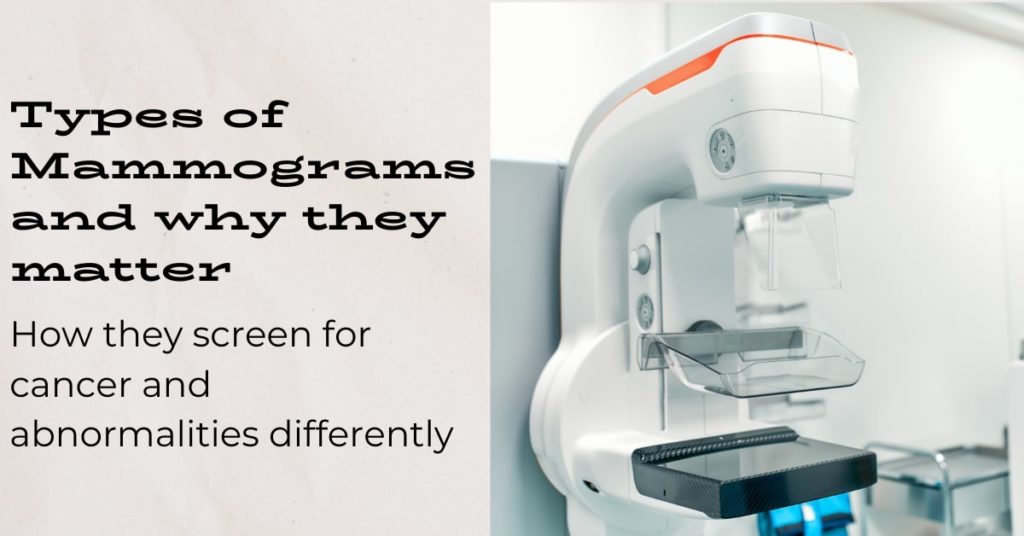Most women are well aware that yearly mammograms are an integral part of keeping track of your breast health. What is often left out of the conversation is that there are a few different types of mammograms that serve slightly different purposes. It’s time that we help take the confusion out of these tests so you can be better prepared and more educated for your trip to the clinic.
Film-screen mammograms
A film-screen mammogram is the most traditional kind of screening that involves printing the images on film. Although these use X-rays just like the other types of mammograms, they are more likely to give a false positive for an abnormality. With film, it’s impossible to increase the contrast of the images, zoom in, and thoroughly examine it the way digital would allow. Still, if traditional film-screen mammograms are your only option, it is much better than nothing. If something strange is detected, it should always be followed up with a diagnostic mammogram or an ultrasound to get a clearer picture of what’s going on.
Digital mammograms
Most imaging centers are switching over to digital mammography, also called full-field mammography. This technology is more accurate and sensitive than just using film. Breast tissue images can be viewed on a computer monitor and the contrast can be adjusted so that abnormalities are spotted more easily. They’ve also proved themselves to be more reliable for detecting cancer in women with dense breasts, women under 50 and those who are premenopausal. One other pro to digital imaging is that it delivers less radiation and takes less time than traditional mammograms. Keep in mind that as digital begins to fully replace film, more women are getting called in for a diagnostic test when an abnormality is spotted. If this happens to you, just know that there are a few reasons that a mammogram comes back abnormal: you may have a cyst, have small calcium deposits in your breast (microcalification), or just very dense breasts. The good news is that most abnormal mammograms do not indicate cancer.
3D mammograms
Of all the types of mammograms, this development uses the newest technology that allows for even better detail. 3D mammograms- also called digital breast tomosynthesis (DBT)- not only allows radiologists to adjust photos and examine precisely, but the images are layered. Having the ability to “peel back” images’ layers to further investigate features of the breast tissue has resulted in fewer false positives for cancer.
Diagnostic mammogram
A diagnostic mammogram is simply a mammogram that is done when an abnormality shows up on a previous test or symptoms of breast cancer appear. There is more detail in the x-ray and the radiologist may choose to take more images from different angles of the breast. Scintimammography counts as a type of diagnostic test- it involves using a radiotracer, a small amount of radioactive material that is injected into the breast. With breast specific gamma imaging (BSGI), the radiotracer is tracked and it accumulates in suspicious areas of the breast. It allows the radiologist to figure out whether a biopsy is needed or not. Other non-invasive ways of following up with an abnormal mammogram may be suggested, too. Radiologists also use positive emission tomography (PET) scans, magnetic resonance imaging (MRI), and ultrasounds to confirm if a biopsy is needed or not.
More tips to consider
It may seem like a pretty straightforward task to get annual mammograms done, but there is quite a lot you can do to take charge of your health:
- Get your mammograms done at the same place every year. Their images can be more easily compared year to year.
- If you’re going to a new facility, have your old mammograms printed out or sent over.
- Schedule your mammogram around your menstrual cycle so that your breasts won’t be as tender during the scan.
- Don’t apply any deodorant, lotions, creams etc around your chest because it can sometimes show up on the scan as white spots
- Tell the technologist if you think you may be pregnant, have implants, or have had any breast changes.
Knowing the different types of mammograms can be extremely helpful, more so is just getting started with yearly exams and staying consistent. Some women may find it uncomfortable, but the whole procedure only takes about 20 minutes and it may very well save your life one day!
